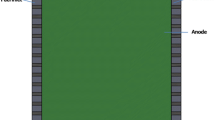Abstract
Through the statement of the turbulent Navier-Stokes equations and Maxwell’s equations a mathematical representation is developed for the electromagnetic force field and the velocity field in the slag phase and the metal pool of cylindrical ESR units. Computed results are presented for both industrial scale (0.5 m electrode diameter) and laboratory scale (0.05 m electrode diameter) units operating with direct currents. It was found that for industrial scale units, the computed slag velocities ranged from 5 to 10 cm/s, while the velocities in the metal pool were substantially lower, except at the slag-metal interface. At a given spatial position, the velocity was found to increase in an almost linear fashion with the current density. The flow was found to be predominately laminar in the laboratory scale units and for comparable current densities the melt velocities were very much smaller. Some 600 to 900 s were required on a CDC 6400 digital computer for the solution of each case involving turbulent flow.
Similar content being viewed by others
Abbreviations
- B :
-
magnetic field,
- C D :
-
dissipation rate constant,
- C 1 :
-
constants of “two-equation model” of
- C 2 :
-
turbulence,
- C 3 :
-
Eelectric field
- Fb,Fr,Fθ,Fz :
-
body force vector and its components inr-, θ-, z-direction
- H,Hr,Hθ,Hz :
-
magnetic field intensity and its components,
- J,Jr,J θ,Jz :
-
current density and its components,
- k :
-
kinetic energy of turbulence,
- L o :
-
characteristic length,
- r :
-
radial coordinate,
- R e :
-
radius of the electrode,
- R m :
-
inside radius of the mold,
- R M :
-
magnetic Reynolds number,
- t :
-
time,
- V,V r, Vz :
-
velocity vector and its components inr- and z-directions,
- V o :
-
characteristic velocity,
- w :
-
characteristic property of turbulence,
- X j :
-
values of the dependent variable at grid pointj at iNth, iteration,
- x oj :
-
values of the dependent variable at grid pointj at(n-1), iteration,
- z :
-
axial coordinate,
- z1 :
-
length of electrode immersed in slag phase,
- z2 :
-
depth of slag phase,
- Z3 :
-
total depth of the slag and the metal pool
- η:
-
magnetic diffusivity,
- μ, μt, μe :
-
molecular, turbulent and effective viscosity,
- μo :
-
magnetic permeability,
- ξ:
-
θ-component of the vorticity vector,
- ρ :
-
density,
- σ e,σs,σm :
-
electrical conductivity of electrode, slag and molten metal,
- σk,σw :
-
Schmidt number ofk andw,
- Ψ :
-
stream function,
- ∈:
-
convergence criterion
References
A. Mitchell, J. Szekely, and J. F. Elliott:Proc. Int. Symp. Electro-Slag Remelting, pp. 3–15, Sheffield, England, 1973.
J. Campbell:J. Metals, July, 1970, vol. 22, p. 23–35.
S. A. Metz and M. C. Flemings:AFS Trans., 1970, vol. 78, p. 453.
A. A. Tsavaras:Proc. Symp. on Continuous Casting, p. 197, Chicago, AIME, 1973.
R. C. Buehl and J. K. McCauley:Trans. Inst. Voc. Met. Conf., 1967, pp. 695–709.
D. B. Spalding:VDI-Forschungsh., 1972, vol. 38, no. 549, pp. 5–16.
L. D. Landau and E. M. Lifshitz:Electrodynamics of Continuous Media, Addison-Wesley, Reading, Mass., 1960.
W. F. Hughes and F. J. Young:The Electromagneto-dynamics of Fluids, John Wiley, New York, N.Y., 1966.
J. Szekely and K. Nakanishi:Met. Trans. B, 1975, vol. 6B, pp. 245–56.
J. Szekely and S. Asai:Trans. Iron Steel Inst. Jap., 1975, vol. 15, pp. 270–75.
J. Szekely and S. Asai:Ibid, 1975, vol. 15, pp. 276–85.
A. D. Gosman, W. M. Pun, A. K. Runchal, D. B. Spalding, and M. Wolfshtein:Heat and Mass Transfer in Recirculating Flow, Academic Press, London and New York, 1969.
J. Szekely and A. H. Dilawari:Proc. 5th Int. Symp. on Vacuum Metallurgy and Electroslag Remelting Process, Munich, 1976 (in press).
J. F. Elliott and M. A. Maulvault:Elec. Furnace Conf. Proc., AIME, 1970, vol. 28, p. 13.
A. Mitchell and S. Joshi:Met. Trans., 1971, vol. 2, pp. 449–55.
Author information
Authors and Affiliations
Additional information
Presently on leave from Institute of Chemical Engineering and Technology, Punjab University, Lahore-1, Pakistan.
Rights and permissions
About this article
Cite this article
Dilawari, A.H., Szekely, J. A mathematical model of slag and metal flow in the ESR Process. Metall Trans B 8, 227–236 (1977). https://doi.org/10.1007/BF02657651
Received:
Issue Date:
DOI: https://doi.org/10.1007/BF02657651




